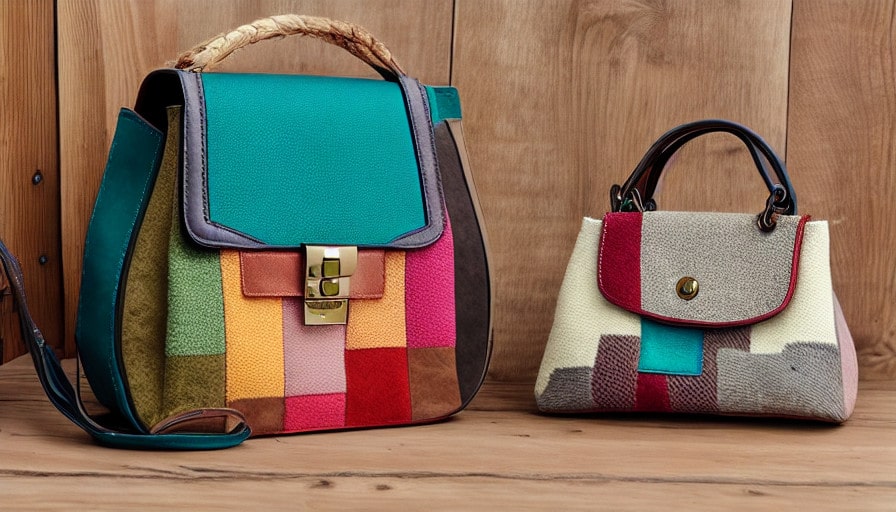DIY handmade handbag tutorial
The general steps for making a DIY handmade handbag:
Materials:
- Fabric of your choice (outer and lining)
- Interfacing or stabilizer
- Zipper or closure of your choice
- Thread
- Sewing machine
- Scissors
- Pins
- Iron
Steps:
- Cut out the fabric pieces for the outer and lining of the bag, as well as the interfacing or stabilizer. Make sure to include seam allowance.
- Fuse the interfacing or stabilizer to the wrong side of the outer fabric pieces according to the manufacturer’s instructions.
- Pin and sew the outer fabric pieces together, right sides facing, leaving the top of the bag open.
- Repeat step 3 for the lining fabric pieces, but leave a small gap at the bottom for turning.
- Turn the outer fabric piece right side out and insert it into the lining fabric piece, right sides facing. Pin and sew around the top of the bag.
- Turn the bag right side out through the gap in the lining.
- Sew the gap in the lining closed.
- Add the closure or zipper to the top of the bag according to the manufacturer’s instructions.
Optional:
- Add pockets to the lining or outer fabric pieces before sewing them together.
- Add straps or handles to the bag.
Note: This is a general tutorial and can be modified based on the style and size of the handbag you want to make. It’s recommended to have some basic sewing skills before attempting to make a handbag.
Best materials for handmade handbags
There are a variety of materials that can be used to make handmade handbags, depending on the desired look, durability, and functionality. Here are some options to consider:
- Leather: Leather is a durable and long-lasting material that can give a high-end look to a handbag. It’s available in different textures, finishes, and colors, and can be used for both the outer and lining of a bag.
- Canvas: Canvas is a strong and sturdy material that can be used for the outer fabric of a handbag. It’s available in different weights, colors, and prints, and can be water-resistant if treated properly.
- Denim: Denim is a versatile material that can give a casual and stylish look to a handbag. It’s durable and can be used for both the outer and lining of a bag.
- Cotton: Cotton is a lightweight and breathable material that can be used for both the outer and lining of a handbag. It’s available in different colors and prints, and can be easily customized.
- Faux leather or vegan leather: Faux leather or vegan leather is a synthetic material that can give a similar look and feel to real leather, but is more affordable and animal-friendly.
- Upholstery fabric: Upholstery fabric is a heavy-duty and durable material that can be used for the outer fabric of a handbag. It’s available in different textures, colors, and patterns, and can be water-resistant and stain-resistant.
- Recycled or upcycled materials: Recycled or upcycled materials such as old jeans, t-shirts, or curtains can be used to make unique and eco-friendly handbags.
Remember to consider the weight, texture, and thickness of the material when choosing it for a handbag. Some materials may require additional support or reinforcement to ensure the bag holds its shape and is durable.
Unique handmade handbag designs
There are many unique handmade handbag designs to choose from, depending on your style and preference. Here are a few ideas:
- Embroidered handbags: Add a personal touch to your handbag by embroidering a design onto the fabric. You can use different colors and stitches to create a unique and eye-catching look.
- Patchwork handbags: Combine different fabrics and prints to create a patchwork handbag. You can use scraps of fabric or repurpose old clothes to create a one-of-a-kind bag.
- Woven handbags: Use a weaving technique to create a handmade handbag. You can use different materials, such as yarn or ribbon, to create a unique and textured design.
- Fringe handbags: Add fringe to the bottom or sides of a handbag to create a bohemian or Western-inspired look. You can use leather, suede, or fabric to create the fringe.
- Beaded handbags: Add beads to the fabric of a handbag to create a textured and intricate design. You can use different colors and sizes of beads to create a unique pattern.
- Foldover clutch: Create a simple and elegant clutch by folding over a piece of fabric and adding a closure. You can use different fabrics and closures to create a variety of designs.
- Bucket bag: Create a slouchy and spacious bag by sewing together a circular base and a cylindrical body. You can use different fabrics and add straps to create a unique look.
Remember, the possibilities are endless when it comes to handmade handbag designs. Get creative and experiment with different materials and techniques to create a bag that’s uniquely yours!
Tips for making durable handmade handbags
If you want to make durable handmade handbags, here are some tips that can help:
- Choose high-quality materials: Invest in high-quality materials that can withstand wear and tear. Choose sturdy fabrics, such as canvas or leather, and durable hardware, such as zippers and clasps.
- Use a strong thread: Use a heavy-duty thread, such as nylon or upholstery thread, to sew your handbag. This will ensure that the seams are strong and won’t easily come apart.
- Reinforce stress points: Stress points, such as the handles and corners of the bag, are more prone to wear and tear. To make your bag more durable, reinforce these areas with additional layers of fabric or interfacing.
- Add a lining: Adding a lining to your handbag can help protect it from wear and tear. Choose a fabric that is strong and durable, such as cotton or polyester.
- Use proper stitching techniques: Use proper stitching techniques, such as backstitching, to ensure that your seams are strong and won’t easily come apart.
- Test your bag: Before using your handbag, test it to make sure it can withstand normal wear and tear. Fill it with items that are similar in weight to what you plan to carry and use it for a day to see if any areas need reinforcement.
By following these tips, you can create handmade handbags that are not only beautiful but also durable and long-lasting.
Different types of handles for handmade handbags
There are various types of handles that you can use for handmade handbags. Here are some examples:
- Shoulder straps: These are long straps that can be worn over the shoulder. They can be made from different materials, such as leather, fabric, or chain, and can be adjustable or fixed in length.
- Crossbody straps: These are similar to shoulder straps, but they are longer and can be worn across the body. They are often used for bags that need to be hands-free, such as messenger bags or camera bags.
- Top handles: These are short handles that are attached to the top of the bag. They are often used for structured bags, such as satchels or doctor bags.
- Chain straps: These are straps made from chains or a combination of chains and fabric. They can add a touch of glamour and sophistication to a handbag.
- Rope handles: These are handles made from rope or twisted cord. They can give a nautical or beachy feel to a handbag.
- Bamboo handles: These are handles made from bamboo or other natural materials. They can give a bohemian or tropical vibe to a handbag.
- Ring handles: These are handles that are attached to the bag with metal rings. They can add a unique and modern touch to a handbag.
By choosing the right type of handle for your handmade handbag, you can add both functionality and style to your design.
How to make a clutch-style handmade handbag
Making a clutch-style handmade handbag can be a fun and rewarding project. Here are the basic steps to create your own:
Materials:
- Fabric for the outer shell
- Fabric for the lining
- Fusible interfacing
- Magnetic snap closure
- Sewing machine and thread
- Scissors
- Iron and ironing board
- Pins
- Ruler or measuring tape
Instructions:
- Cut the fabric for the outer shell and the lining to your desired size. A common size for a clutch-style handbag is around 10 inches by 6 inches.
- Cut a piece of fusible interfacing the same size as the outer shell fabric. Iron it onto the wrong side of the outer shell fabric to add structure and stability.
- Place the outer shell fabric and lining fabric right sides together and sew along the two longest sides and one short side, leaving one short side open. Trim the corners.
- Turn the bag right side out and press it flat. Fold the open edge in about 1/2 inch and press it flat.
- Sew the magnetic snap closure onto the flap of the clutch. The snap should be placed on the wrong side of the outer shell fabric, about 1/2 inch from the top of the flap.
- Fold the clutch in half so that the snap closure is on the outside. Pin the sides together and sew along the open edge.
- Turn the bag right side out and press it flat.
- Your clutch-style handmade handbag is now ready to use! You can decorate it with embellishments, such as beads or embroidery, to add a personal touch.
By following these steps, you can make a simple but stylish clutch-style handmade handbag that is perfect for a night out or any occasion when you want to travel light.
Eco-friendly materials for handmade handbags
If you’re interested in making eco-friendly handmade handbags, there are several sustainable materials you can use. Here are a few ideas:
- Cork fabric: Cork is a sustainable and renewable material that comes from the bark of the cork oak tree. Cork fabric is a great option for handbags as it is lightweight, durable, and water-resistant.
- Organic cotton: Conventional cotton is one of the most environmentally damaging crops, so using organic cotton instead is a great way to reduce your impact. Organic cotton is grown without harmful pesticides and chemicals, making it a more sustainable choice.
- Recycled fabric: There are many companies that make fabric from recycled materials, such as plastic bottles or discarded clothing. Using recycled fabric is a great way to reduce waste and give new life to materials that would otherwise end up in a landfill.
- Hemp: Hemp is a sustainable material that requires very little water and no pesticides to grow. It is also durable and strong, making it a good choice for handbags.
- Upcycled materials: Upcycling involves using materials that would otherwise be thrown away, such as old denim or leather jackets, and turning them into something new. Upcycling is a great way to reduce waste and create unique, one-of-a-kind pieces.
By using eco-friendly materials in your handmade handbags, you can create beautiful, sustainable pieces that are both stylish and kind to the planet.

